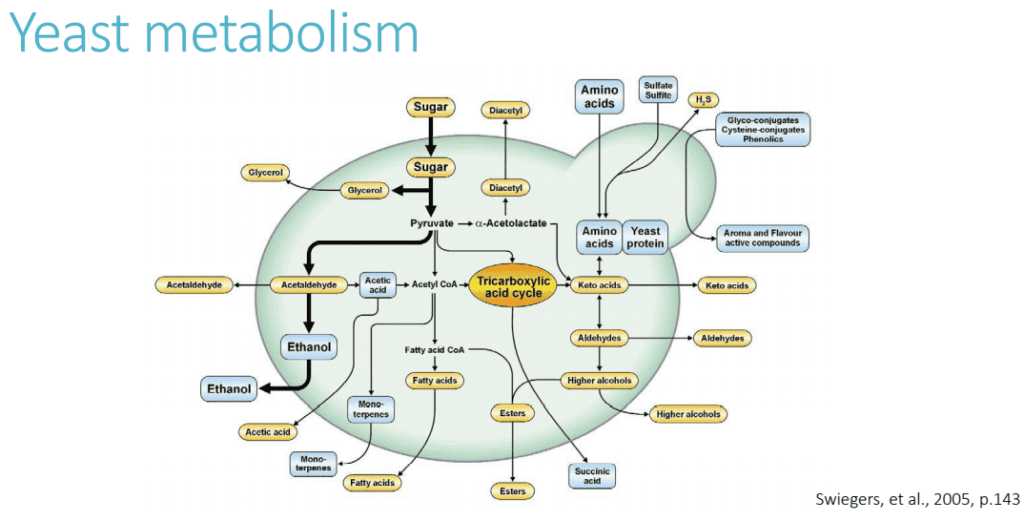Terpenes, Esters, Yeasts, and the Magic of Fermentation
What defines the flavors of mezcal? Mezcal is defined by the terpenes found in agave and natural fermentation without added yeast. The different alcohols, acids, aldehydes, and esters that impact the flavors of mezcal that are produced during fermentation.
One of the most widespread studies on the volatile compounds in mezcal identified 85 components classified into nine different chemical groups (J. A. Molina-Guerrero, 2007). It should be noted that this study was conducted with ten commercial mezcals, all of which were made from espadín. In subsequent research, in which mezcals originating from different villages were analyzed, 97 compounds were found distributed in 10 groups (Barrón, 2012). Of these groups, I consider terpenes, esters, and aldehydes (depending on their concentrations) to be the most important in determining the flavors of mezcal (and any craft distillate).
So let’s talk about terpenes first.
How do terpenes contribute to the flavor of mezcal?
We are all familiar with terpenes: citrus aromas, as well as those of herbs such as menthol, rosemary, or peppermint, come from these compounds. Linalool, a terpene found in all mezcals, is widely used in soaps, cleaning products, and repellents such as Lysol, Mrs. Meyer’s Clean Day, and Off!
Terpenes are the organic compounds that the agave contributes to mezcal. When you detect those fresh, herbal, or tree resin aromas in a mezcal, your senses perceive the soul of the plant. Terpenes represent a vast family with different properties and functions depending on their structure and origin, whether plant or animal.
Terpenes play a crucial role in many vital processes in plants. For example, they are part of the essential oils, saps, and tissues of some plants. Some heavier terpenes are predominant in tree resins and can attract or repel insects (Lidefer, 2024).
The area of terpenes and mezcal agaves certainly merits further study, but three existing studies provide appealing information. One relevant study was conducted in 2008 by Jorge Luis Santos Hernandez, who analyzed six mezcal agaves and found the following terpenes:

In that study, 12 terpenes were found in Agave angustifolia. Terpenes are part of essential oils, and special care is required during distillation to recover these heavy molecules. This is perhaps why traditional mezcal producers always emphasize that slow distillation is essential to make the best mezcal.
Why is high ABV mezcal more complex?
Alcohol is more compatible with terpenes and esters because it has characteristics that allow better interaction with their nonpolar parts, while water, being very polar, does not dissolve these substances well. That is why low ABV mezcals that contain more water than alcohol will have less complexity.
In this chart, you can see that of the 16 terpenes identified in the agave, only four were found in the 40% alc. mezcal (Espinosa, 2004).

In the third and last table, mezcals with higher alcohol content were analyzed: four espadines from Oaxaca (M1, M2, M3, M4) and one Agave salmiana mezcal from San Luis Potosi. Nine terpenes were found in the espadín and 20 terpenes in the salmiana. A feast of flavors in the palate!

How does fermentation contribute to the flavor of mezcal?
Although I am not a religious person, studying fermentation has made me reconsider my position. As Benjamin Franklin said, “Beer is proof that God loves us and wants us to be happy.” I would say that yeasts are proof that God loves us and wants us to enjoy mezcal. The fortunate coincidences that occur during natural fermentation are fascinating.
It is important to note that we do not know all the existing yeast species–to say the least! Currently, only 100 genera have been studied out of a possible 62,000, and only 700 species out of an estimated 669,000 (Kevin J. Verstrepen et al., 2006). The yeast Saccharomyces cerevisiae, for example, was described by Emil Christian Hansen in 1883 and is fundamental in the alcoholic beverage industry due to its efficiency in producing ethyl alcohol. These yeasts are so important that yeasts are generally classified into Saccharomyces and non-Saccharomyces.
Comparing yeast activity to something as simple as “eat sugar and produce alcohol” is simplistic. Yeasts have complex metabolic pathways that generate a variety of compounds, including higher alcohols, esters, and acids, which are key to the flavor of mezcal.
In maguey juice fermentation, higher alcohols and esters are produced in abundance (Díaz Montaño et al., 2008; Segura-García et al., 2015). The production of these compounds depends on the yeast species, coexistence with other species, temperature, and carbon and nitrogen concentration (Molina et al., 2007; Saerens et al., 2010; Duarte et al., 2013; Liu et al., 2016). In the next image we can see the different compounds that the yeast generate.

A 2018 study in 17 palenques in Oaxaca identified the predominant yeast species. Surprisingly, in 30% of the palenques they did not find Saccharomyces as the dominant yeast and instead found others that are generally considered as undesirable contamination in the fermenting industry including Pichia kudriavzevii, Pichia manshurica, and Kluyveromyces marxianus (Nolasco-Cancino et al., 2018). These yeasts are considered “contaminations” because they are too lazy to produce alcohol and produce other compounds that producers cannot control. In standardized processes, this is the worst.
How do esters contribute to the flavor of mezcal?
Because the production of artisanal mezcal in rural villages is not exactly standardized, it’s impossible to create a table that consistently relates the specific flavors of the mezcals to the species of maguey used.
The precise identification of the maguey used in a village mezcal is complicated by one fundamental aspect: esters.
We are all familiar with esters, although we may not recognize them by name. These compounds are responsible for the fruity flavors and aromas in many foods and products. When we were kids and tasted a piece of candy or chewed a piece of gum, we were tasting a lot of esters. Any food or product that reminds you of ripe fruits is full of them. In this image, you can see some examples of esters and their associated aromas.

In mezcals, esters play a crucial role in defining the spirit’s sensory characteristics (Barrón, 2012). These compounds can be formed during fermentation, distillation, and even maturation of mezcal.
The basic formula of an ester is the combination of an acid molecule with an alcohol molecule that react to form an ester and water. In this image, we can see how alcohols and acids react to form esters with specific odors.

A clear example of the importance of this process is the production of isoamyl alcohol during fermentation. This alcohol, with an aroma similar to rancid butter, reacts with acetic acid to generate an ester that smells exactly like Laffy Taffy banana (Golikova, 2019), an aroma that can dominate the mezcal profile and mask other compounds such as terpenes from the maguey.
I have detected this banana aroma in mezcals from Miahuatlán, Sola de Vega, and San Luis del Río. It is essential to note that this smell is not related to the raw material but to the wild fermentation, the yeasts, and the distillation process.
The mezcal from the villages is a deeply complex spirit, with flavors that depend on a variety of factors, from the yeast species to the organic compounds present in the agave. Learning this science provides deeper insights into mezcal and another way to honor the rich flavors that mezcaleros so carefully craft.
Bibliography:
Barrón, S. E. (2012). Efecto de la región de procedencia del agave y las condiciones de fermentación sobre el perfil aromático del mezcal. Guadalajara, Jalisco.
Dulce M Díaz-Montaño, M.-L. D.-E. (2008). Fermentative capability and aroma compound production by yeast strains isolated from Agave tequilana Weber juice. Enzyme and Microbial Technology, 608-616.
Espinosa, M. A. (2004). Determinación de terpenos en Agave tequilana Weber var. azul, Agave angustifolia, Agave salmiana y en sus respectivas bebidas alcohólicas. CDMX.
Golikova, A. T. (2019). Excess enthalpies and heat of esterification reaction in ethanol + acetic acid + ethyl acetate + water system at 313.15 K. J Therm Anal Calorim, 1301-1307.
Hernández, J. L. (2008). Identificación y cuantificación de terpenos en agave mezcalero por microextracción en fase sólida-cromatofrafía de gases-espectrometría de masas.
J. A. Molina-Guerrero, J. E.-Á.-B.-B.-I. (2007). Compuestos volátiles en el mezcal. Revista Mexicana de Ingeniería Química, 41-50.
Kevin J Verstrepen, P. J. (2006). The Development of Superior Yeast Strains for the Food and Beverage Industries: Challenges, Opportunities and Potential Benefits. Yeasts in food and beverages, 399-444.
Lidefer. (2024). Lidefer.com. Obtenido de https://www.lifeder.com/terpenos/: https://www.lifeder.com/terpenos/
Nolasco-Cancino Hipócrates, S.-U. J.-T. (2018). Predominant Yeasts During Artisanal Mezcal Fermentation and Their Capacity to Ferment Maguey Juice. Frontiers in Microbiology.
Swiegers, J. &. (2005). Yeast and bacterial modulation of wine aroma and flavour. Australian Journal of Grape and Wine Research, 139-173.Vizzuett, J. A. (2017). El mezcal: una revisión química, tecnológica e histórica.












This is a fabulous article with great insight into what elements give artisanal mezcal its complex aromas and flavors. Well done!